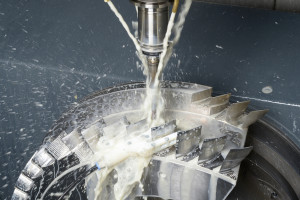Flying somewhere for vacation or jetting off to Rome, Paris or Madrid for a long weekend? Air traffic is on the rise, and passenger traffic in particular doubles every fifteen years. That’s why manufacturers of aircraft turbines are trying to match their production capacity to this increased demand. It’s not easy: Turbine blades are mounted on compressor disks, and to make these disks as light as possible, they are now milled from a single piece of material rather than constructed blade by blade, as they were in the past. Compressor disks made this way are known as “blade-integrated disks” or “blisks”, and their job is to compress air in the turbine. But because turbine blades are by nature long and thin, manufacturing them all at once causes problems. They begin to vibrate like a tuning fork during production, which complicates any further work. To avoid this, manufacturers don’t mill each blade completely, but instead precede step by step – manufacturers process the outer edge of the blade to its finished state before moving on. However, this manufacturing process has its own problems; the tension on the turbine blades causes their geometry to become slightly warped. A new clamping system from the Fraunhofer Institute for Production Technology IPT in Aachen promises a remedy for eliminating blade vibration. “With the clamping system, absorption in titanium blisks is 12.5 percent. Without it, absorption falls to just 0.027 percent,” says Roman Kalocsay, an engineer at IPT. Using the clamping system, manufacturers can roughly mill the blades first, and then perform the precise finishing work because the blades no longer vibrate. Eliminating vibration with the clamping system slashes manufacturing costs, too – as much as 5000 euros per blisk. The components can cost between 30,000 and 80,000 euros because vibrating blades also put a strain on the tools’ cutting edge, forming fissures that quickly increase in size with mechanical and thermal stress. Tools often have to be replaced after cutting only four meters’ worth of material. Initial experiments with the clamping system, however, suggest that tools could be used about two to three times longer than before. So how does the clamping system work? “Spring-loaded clamps automatically grasp the blade with equal amounts of tension on both sides,” Kalocsay explains.
“As soon as the elements are in position, they are hydraulically clamped in place and hold the workpiece as if it had grown there.” The clamping system prototype was created by the Fraunhofer Innovation Cluster Adaptive Production for Resource Efficiency in Energy Generation and Mobility AdaM. During repair, the blades cannot be milled piece by piece out of the material – after all, all of the blades are already in place. Instead, if their edges appear to be “frayed”, for example, the manufacturer reapplies the material using laser metal deposition and then mills it to the desired form. Workers attempt to hold the blade in place as best they can using clamps or rubber, but it is nearly impossible to align them perfectly. Consequently, the workpieces must be re-measured afterwards in a time-consuming process because it is not clear how much they have drifted to the left or right. The clamping system helps here, too. “It doesn’t change the blisk’s geometry by even a micrometer. The blade is fixed in place in just a few seconds and can be worked on immediately,” says Kalocsay. The process is slightly different than with a new blisk, however: The clamping elements are arranged in a circle and hold, not one, but all blades at the same time.




